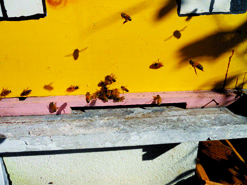Tucking bees in for winter

The first year beekeeper sitting next to me at the Fall Bee Festival in Kansas City acted very nervous. When I asked if she was ok, she said she was worried about what to do to get her bees ready for winter.
Bees don’t hibernate, they spend winter literally shivering in a ball inside the hive. Beekeepers aren’t supposed to peek inside hives for months, which can be unnerving, especially to someone just starting to keep bees.
I told her during my first year of keeping bees, I covered my hives with quilts, which helped me more than it did the bees. She smiled. Apparently I wasn’t the first beekeeper to think tucking bees in for winter wasn’t such a bad idea.
There are a number of reasons why honeybees die over winter; some a beekeeper can do something about, other reasons are part of nature’s design to eliminate weak bee colonies and allow only the strong bee colonies to pull through.
The first reason bees die over winter is starvation. Honey is the bees version of canning, storing dehydrated nectar to eat through the cold months. If there are warm days during winter and bees leave the hive to fly, they consume more honey. Sometimes by the end of January, bee colonies may run out of food. I for one want my bees to take care of themselves but I do feed my bees to make sure they have enough to eat until spring.
Some colonies also die over winter because of exposure to varroa mites, tiny blood-sucking mites that carry viruses that weaken bee colonies. Usually by the 2nd and 3rd year, a colony is so infected with viruses the colony can’t pull through winter and dies. Treating for the mites and keeping track of mite numbers are critical to helping a colony healthy.
The condition of their hives can also be a factor. If there is water condensation dripping back on the bees, they will get wet and die. Humidity can also lead to chalkbrood, when bees in their hatching cells turn into little mummies before hatching.
If there are cracks in the hives and wind can move through, bees will also get chilled and die.
If beekeepers can’t stand the wait and crack the hive open in the middle of winter to see how the bees are doing, they break the weather-proofing seal bees install in fall. With no time to rebuild the seals, and record low numbers of bees, the colony can die from exposure.
Although tempting, it’s also not a good idea to move a hive into a garage or basement. If bees think the outside temperature is warm, they will break cluster and fly out of the hive, consuming more food and getting disoriented. They also will fly towards lights since they navigate by the sun and that has its own challenges.
The best thing to tuck bees in for winter is to make sure they have a wind break and stay out of the hives until spring. I know, easier said than done.
Charlotte Ekker Wiggins is a certified gardener, beekeeper and sometimes cook. Copyright 2016 used with permission, all rights reserved. This material may not be published, broadcast, rewritten or redistributed. Contact Charlotte at chargardens@gmail.com.

REDUCING AIR FLOW – The first change I make in my hives for winter is to replace a screened inside hive top with a solid one. The solid inside cover helps keep the hive warm through winter.

SMALLER FRONT DOOR HELPS -One of the ways to help bees stay warm in hives over winter is to reduce the size of the hive front door. Entrance reducers help to close up the hive entrance so bees still can fly in and out while keeping the inside bee cluster warm. (Photos by Charlotte Ekker Wiggins).



Facebook Comments